Horseradish
- Scientific name: Armoracia rusticana
- Family: Cruciferae
- Parts Used: Tap root, leaves (occasionally)
- Actions: Stimulant, Carminative, Rubefacient, mild Laxative, Diuretic, Hepatic, Vermicide
The Egyptians knew about horseradish as far back as 1500 B.C. Early Greeks used it as a rub for lower back pain and an aphrodisiac. Jews still use it during Passover seders as one of the bitter herbs. Some used horseradish syrup as an expectorant cough medicine; others were convinced it cured everything from rheumatism to tuberculosis. Legend has it the Delphic oracle told Apollo, “The radish is worth its weight in lead, the beet its weight in silver, the horseradish its weight in gold.”
Horseradish is an old household remedy useful wherever a stimulating herb is called for. It can be used in influenza and fevers as a rough equivalent to Cayenne Pepper. It stimulates the digestive process whilst easing wind and griping pains. It has been used in cases of urinary infection. Externally it has a stimulating action similar to Mustard Seed. It can be used for rheumatism and as a poultice in bronchitis.
Fresh horseradish root contains calcium, magnesium, sodium, vitamin C, and has antibiotic qualities. According to WebMD, Horseradish might help fight bacteria and stop spasms.
A tea or decoction of horseradish is antiseptic, stimulant, laxative and strongly diuretic, but as it becomes a purgative when taken in large doses it is best to be cautious. It is often best used when applied externally. Apply grated fresh root to aching joints and chilblains, or infuse it in milk as a skin tonic. Traditionally taken to expel worms, horseradish has only been used as a food during the last two or three hundred years.
This plant has been in cultivation from the earliest times, but its exact place of origin seems to be obscure. It is probably the plant mentioned by Pliny under the name of Amoracia, and recommended by him for its medicinal qualities, being then apparently employed exclusively in physic, not as food or condiment. Both the root and the leaves of Horseradish were universally used as a medicine during the middle ages.
Description
Horseradish is a perennial with large, narrow, sometimes deeply cut leaves and a thick, tapering, fleshy root. In temperate climates long, loose panicles of white, four-petaled flowers occasionally appear in midsummer, but the seeds seldom ripen.
Cultivation and Collection
Look for Horseradish on wasteland, near old railway lines and on verges. Gather in autumn, remembering that you need the landowner’s permission to dig up the roots. Store freshly-lifted roots in a bucket of dry sand and they’ll keep for months. Alternatively, Horseradish freezes quite well when wrapped tightly.
Plant out sections of the root 25 cm (10 inches) apart and 30 cm (12 inches) deep in richly manured ground in early spring. Horseradish easily spreads and becomes a pest, so lift the roots each fall and store in moist sand, planting some out again the following year. It is recommended to replant the bed every few years, otherwise you may find that your crop will deteriorate in quality.
According to folklore one should always dig horseradish in a month with an “r” in it. And I would assume, conversely, never in a month without an “r” in it. I wonder if this is specific to English? Or would it apply in your region to whatever language is common?
Medicinal Uses
Some people take horseradish by mouth for urinary tract infections, kidney stones, fluid retention, infections of the respiratory tract, cough, achy joints (rheumatism), gallbladder disorders, sciatic nerve pain, gout, colic, and intestinal worms in children. Some people apply horseradish directly to the skin for painful and swollen joints or tissues and for minor muscle aches.
Horseradish is good remedy for sore throats and coughs-even whooping cough. Scrape a half a teacupful of horseradish, add a little vinegar to thoroughly soak it. Keep pressing it down so that the horseradish is always just covered by the vinegar. Leave for the day. Then add one tablespoonful of glycerin and mix. Take a half of a teaspoonful in a wineglass of hot water.
Incidentally, horseradish will also help to alleviate that annoying catarrhal deafness that can come with a cold. Take one ounce of the grated root, pour one pint of boiling water over it and let it stand for 15 minutes. Strain, and take 4 tablespoonfuls twice a day. If you don’t like the flavor, mix it with syrup of ginger or caraway.
It is a powerful stimulant, whether applied internally or externally as a rubefacient, and has aparient and antiseptic properties. Taken with oily fish or rich meat, either by itself or steeped in vinegar, or in a plain sauce, it acts as an excellent stimulant to the digestive organs, and as a spur to complete digestion.
It is a very strong diuretic, and was employed by old herbalists in calculus and like affections. It is useful in the treatment of dropsy. Boerhaeve recommended it to be given in scurvy when there was not much fever, and administered it for various other complaints.
If eaten at frequent intervals during the day and at meals, Horseradish is said to be most efficacious in getting rid of the persistent cough following influenza.
Horseradish was formerly much employed as a remedy for worms in children. Coles says: “Of all things given to children for worms, horseradish is not the least, for it soon killeth and expelleth them.”
It was also employed at one time as a highly questionable cure for a toothache. The patient was instructed to hold a poultice of freshly ground horseradish in the left hand if the afflicted tooth was on the right side of the head, and to hold the horseradish poultice in the right hand if the afflicted tooth was on the left side of the head.
Constituents
When unbroken it is inodorous, but exhales a characteristic pungent odor when scraped or bruised, and has a hot biting taste, combined with a certain sweetness.
It has properties very similar to Black Mustard seeds, containing Sinigrin, a crystalline glucoside, which is decomposed in the presence of water by Myrosin, an ensyme found also in the root, the chief produce being this volatile oil, Allyl, isothiocyanate, which is identical with that of Black Mustard seed. This volatile oil, which is easily developed by scraping the root when in a fresh state, does not pre-exist in the root, the reaction not taking place in the root under normal conditions, because the Sinigrin and Myrosin exist in separate cells, and it is only the bruising of the cells that bring their constituents together.
The oil is highly diffusible and pungent on account of the Myrosin contained, one drop being sufficient to odorize the atmosphere of a whole room. On exposure to the air, the root quickly turns color and loses its volatile strength. It likewise becomes vapid and inert by being boiled.
When infused in wine, Horseradish root will stimulate the whole nervous system and promote perspiration.
An infusion of sliced Horseradish in ilk, by its stimulating pungency and the sulphur it contains, makes an excellent cosmetic for the skin when lacking clearness and freshness of color.
Horseradish juice mixed with white vinegar will, when applied externally, help to remove freckles. The same mixture, well diluted with water and sweetened with glycerine, gives marked relief to children in whooping-cough, 1 or 2 dessertspoons being taken at a time.
Preparations
- Infusion:
Pour a cup of boiling water onto 1 teaspoonful of the powdered or chopped root. Leave to infuse for 5 minutes. This should be drunk three ties a day or more often when being used to treat influenza or fever.
- Infusion for Dropsy
Pour 1 pint of boiling water on 1 oz of grated Horseradish and 1/2 ounce of crushed Mustard seed. The iose is 2 to 3 tablespoonfuls three times a day.
- An Official Preparation
A compound spirit of Horseradish may be prepared with slices of the fresh root, orange peel, nutmeg and spirit of wine, which proves effective in languid digestion, as well as for chronic rheumatism. 1 or 2 teaspoonfuls being taken two or three times daily after meals with half a wineglass of water.
- Old School Poultices
“If bruised and laid to a part grieved with the sciatica, gout, joint-ache, or hard swellings of the spleen and liver, it doth wonderfully help them all.” ~Culpepper
“A poultice of the scraped root serves instead of a mustard plaster. Scraped horseradish if applied to chilblains, secured with a light bandage will help to cure them.” ~M Grieve
“For facial neuralgia, some of the fresh scrapings, if held in the hand of the affected side will give relief – the hand in some cases within a short time becoming bloodlessly white and benumbed.” ~M Grieve
- Horseradish Syrup
Horseradish syrup is very effectual in hoarseness. 1 drachm of the root, freshly scraped is infused in 4 ounces of water for two hours in a closed vessel and made into a syrup with double its weight in sugar. The dose is a teaspoonful or two, occasionally repeated.
- Horseradish Tea
Boil water like you would for tea, and then you grate in some horseradish, and add lemon juice and honey. Let it steep, and then drink it as is or you can strain it. It opens you all up when your nose is stuffy and all of that. It is strong. It is delicious.
Science and Research
Researchers hypothesize that glucosinolates increase the body’s ability to detoxify cancer-causing compounds and suppress cancer growth in the body. The levels of these chemicals in horseradish are more than ten times that of broccoli. So just a little bit of horseradish goes a long way in providing these beneficial compounds.
Recent research from University of Illinois has identified compounds in horseradish that may have anti-cancer properties. These compounds, known as glucosinolates, have also been found in cruciferous vegetables such as broccoli, cabbage, and Brussels sprouts, relatives of horseradish. Whether horseradish proves to be a ‘miracle food’ or not remains to be seen. Nonetheless it is still a great addition to many meals and a food that has a lot of history in the world.
- Infection of the airways. Early research shows that taking a specific product containing horseradish root and nasturtium might make infections of the airway happen less often.
- Infections of the kidney, bladder, or urethra (urinary tract infections or UTIs). Early research shows that taking a specific product containing horseradish root and nasturtium might help to prevent recurring UTIs.
Horseradish root was approved as a nonprescription medicine ingredient by the German Commission E for treatment of infections of the respiratory tract and as supportive treatment in urinary tract infections. In the United States, horseradish root is the active ingredient of Rasapen, a urinary antiseptic drug. Horseradish is considered a strong diuretic and, coupled with its antibacterial properties, acts to flush out harmful bacteria or other inflammatory agents in the bladder sooner than they normally would be eliminated.
An Edible Root
Long ago Horseradish was cultivated as a medicinal herb, but in the sixteenth century the Germans began employing it as flavoring in fish sauces. The culinary use of Horseradish spread westwards to Britain, where the sharp pungency of the plant was discovered to be ideal for the national dish, roast beef.
In some areas the young spring shoots of horseradish are cooked for greens.
Horseradish has a large root with a very pungent flavor. High in vitamin C, the root contains similar oils to those in mustard seed and can taste powerfully, even painfully hot, especially near the outer rind. Always use it raw or dried as the flavor is lost when cooked or when exposed to the sun. Horseradish is of little use in cooked dishes.
The “heat” in Horseradish comes from a volatile oil, sinigrin, which is present throughout the plant. The large feathery leaves (which can reach 1 m) emit a pungent aroma when crushed and can, when very young, be added to salads. But it is the grated white flesh of the long long root that is used in Horseradish sauce.
Use freshly grated or dried and powdered in sauces, with hot and cold meat and fish, sausages and vegetables, or macerate slices in vinegar. To make a horseradish sauce, peel and grind the roots, then mix with vinegar. Add grated raw horseradish to grated raw beets and sour cream to make a spicy beet relish.
Try the sauce with oily fish as well as beef. It can also be grated into coleslaw and cream cheese.The first World War forager T. Cameron, who was clearly made of tough stuff, suggested that “the root may be cut across in thin slices and eaten as an hors d’oeuvre like radishes.”
Note: When preparing Horseradish roots, have the kitchen windows wide open; the essential oils released from the root are eye-watering beyond anything onions can do.
The hot, young leaves are one of the bitter herbs of the Jewish Passover. The five bitter herbs of the Seder are served to remind Jews of the bitterness and harshness of their captivity in Egypt.
Horseradish Cooking Tips
- Add a splash to tomato juice for an early morning eye opener.
- Slip a spoonful into a skillet of scrambled eggs.
- Try horseradish on breakfast sausage.
- Give store bought deli items, like cole slaw, potato salad and baked beans, an exciting new taste.
- Mix it with apricot preserves and a little mustard for a great ham glaze.
- Create your own horseradish butter, horseradish mayonnaise, horseradish sour cream dip and horseradish barbecue sauce.
- Make familiar “comfort foods” even more indulgent. Add horseradish to mashed potatoes, meatloaf, applesauce served with pork roast, sour cream on your baked potato.
- A spoonful added to any meat stock adds a delightful flavor and surprisingly delicate horseradish taste to soups.
- For a gourmet appetizer, blend horseradish with softened cream cheese. Spread the mixture on thin slices of rare beef tenderloin and wrap around crisp-tender asparagus spears.
- Cut down on cholesterol by using horseradish instead of butter and salt to top vegetables.
- Season pizza sauce with horseradish before baking for a new twist on an old favorite.
- Follow the example of famed European chefs who use horseradish liberally as an herb. Try adding a spoonful of horseradish to hollandise sauce and serve with salmon or asparagus.
- For tangy deviled eggs, mix together 4 minced, hard cooked egg yolks, 1 tsp. Prepared horseradish, 1 tsp. Minced onion, 1 tsp. Worcestershire sauce, 1/4 C. mayonnaise, 1/2 tsp salt. Spoon mixture into egg-white halves.
- Fill celery stalks with a mixture of 1 cup mashed avocado, and 2 tsp. prepared horseradish. Sprinkle with paprika. Chill
- Blend cream cheese with prepared horseradish for a nippy taste. Spread on thinly sliced ham. Roll up and place, seam side down, on plate. Chill. Cut into bite-size pieces.
- Give corned beef brisket a new taste twist with a horseradish-orange glaze: 2 tbsp. Prepared horseradish, 2 tbsp. Worcestershire, 1/2 C. orange marmalade, 1/2 C. mustard.
- Baste ribs on the grill with a nippy combo of 2 tbsp. dry white wine, 2 tbsp. prepared horseradish, 1 tbsp. vegetable oil and 1/2 tsp. hot mustard.
- Spark up beef stroganoff with a dollop or two of horseradish.
- To a home-made or made-from-a-package pasta and cheese dish, add 1 1/2 C. chopped, cooked ham and 2 tbsp. horseradish mustard. Bake in moderate oven until heated through.
Other Uses
Planted in the corners of a potato patch, horseradish will deter potato bugs.
Folk and Common Names
- Great Railfort
- Mountain Radish
- Moutarde des Allemands
- Red Cole
- Stingnose
Magickal Uses
One of the strongest ingredients for male virility, the Horseradish root is in essence magickal Viagra. It is cultivated in the spring and difficult to find at any other time of the year.
- Women should lay the whole root on the belly and visualize either getting pregnant or being satisfied sexually.
- Men must hold the whole root to the genitals and visualize long-lasting erections.
- Perform these visualizations on a full moon.
Eat both white and red shredded horseradish at any time of the year for protection.
To reverse any malevolent magick against a building’s inhabitants, grate or grind dried horseradish root. Sprinkle it over your thresholds, corners, windows, and any areas perceived as vulnerable.
Cautions and Contraindications
Horseradish root is LIKELY SAFE when taken by mouth in food amounts. It is POSSIBLY SAFE for most people when taken by mouth in medicinal amounts. However, it contains mustard oil, which is extremely irritating to the lining of the mouth, throat, nose, digestive system, and urinary tract. Horseradish can cause side effects including stomach upset, bloody vomiting, and diarrhea. It may also slow down the activity of the thyroid gland.
When used on the skin, horseradish is POSSIBLY SAFE when preparations containing 2% mustard oil or less are used, but it can cause skin irritation and allergic reactions.
- Children less than 4 years old:
Horseradish is LIKELY UNSAFE in young children when taken by mouth because it can cause digestive tract problems.
- Pregnancy and breast-feeding:
It’s LIKELY UNSAFE to take horseradish by mouth in large amounts if you are pregnant or breast-feeding. Horseradish contains mustard oil, which can be toxic and irritating. Horseradish tincture is also LIKELY UNSAFE when used regularly or in large amounts because it might cause a miscarriage.
- Stomach or intestinal ulcers, inflammatory bowel disease, infections or other digestive tract conditions:
Horseradish can irritate the digestive tract. Don’t use horseradish if you have any of these conditions.
- Underactive thyroid gland (hypothyroidism):
There is concern that using horseradish might make this condition worse. Talk to your doctor if you have hypothyroidism before taking horseradish.
- Kidney problems:
There is concern that horseradish might increase urine flow. This could be a problem for people with kidney disorders. Avoid using horseradish if you have kidney problems.
- Levothyroxine interacts with HORSERADISH
Levothyroxine is used for low thyroid function. Horseradish seems to decrease the thyroid. Taking horseradish along with levothyroxine might decrease the effects of levothyroxine.
Some brands that contain levothyroxine include Armour Thyroid, Eltroxin, Estre, Euthyrox, Levo-T, Levothroid, Levoxyl, Synthroid, Unithroid, and others.
Fun Facts and Trivia
- Horseradish is still planted and harvested mostly by hand.
- Sales of bottled horseradish began in 1860, making it one of the first convenience foods.
- In the American South, horseradish was rubbed on the forehead to relieve headaches.
- Horseradish is added to some pickles to add firmness and “nip”.
- Before being named “horseradish,” the plant was known as “redcole” in England and as “stingnose” in some parts of the U.S.
- Horseradish has only 2 calories a teaspoon, is low in sodium and provides dietary fiber. Typically it is also trans fat-free.
- Researchers at M.I.T. claim that the enzyme “horseradish peroxidase” removes a number of pollutants from waste water.
- The most widely recognized horseradish fan in the world may be Dagwood Bumstead, who consumed it regularly in the popular comic strip, “Blondie,” by Dean Young and Stan Drake.
- Germans still brew horseradish schnapps . . . . Some also add it to their beer.
- Al Weider earned a place in the Guinness Book of World Records by tossing a horseradish root 80.5 feet to win the event.
Sources:
- Gypsy Cures for Coughs and Colds
- The Complete Illustrated Holistic Herbal
- The Complete Book of Herbs and Spices
- A Modern Herbal by M. Grieve
- Foraging by John Lewis-Stempel
- Encyclopedia of Magickal Ingredients
- WebMD
- Horseradish.org
Rennie Luttrull: queen-annes-lace-seeds
Rosanna: Spignel aka Bald Money
Annamarie Squatrito: Fumitory
EILEEN Klinghagen: Pumpkin
Mahmudul Hasan: Celery
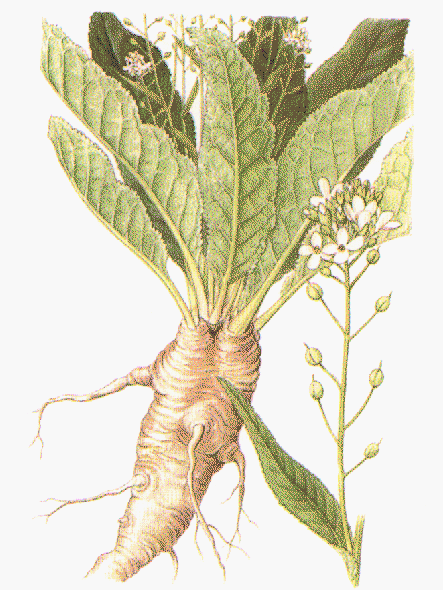
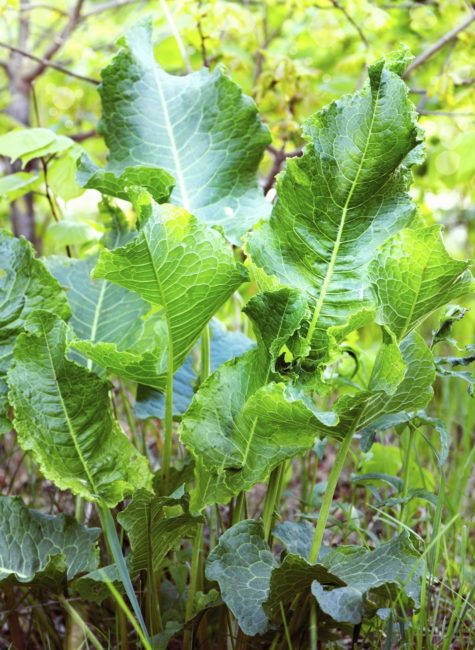
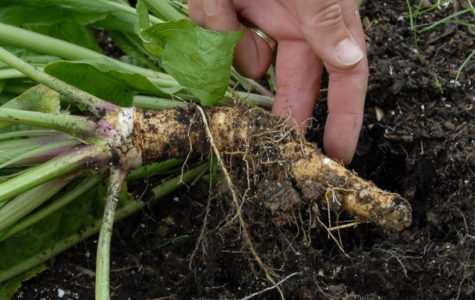
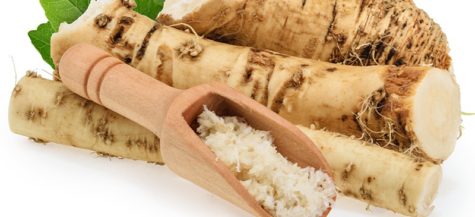
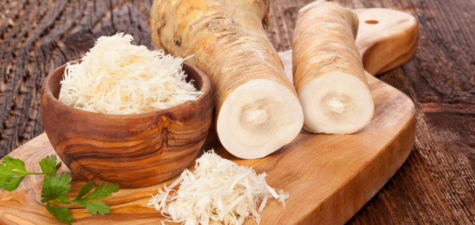
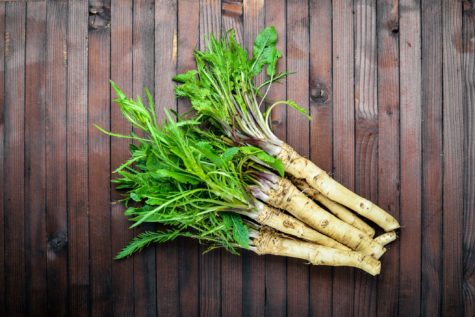
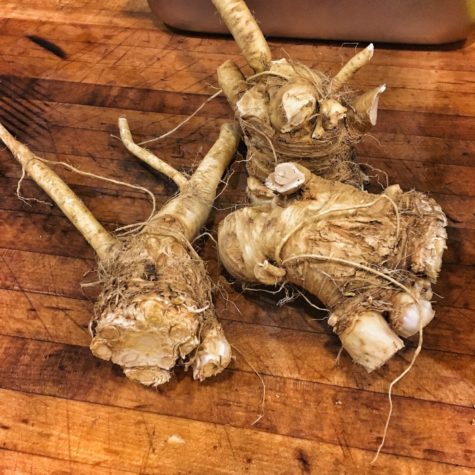
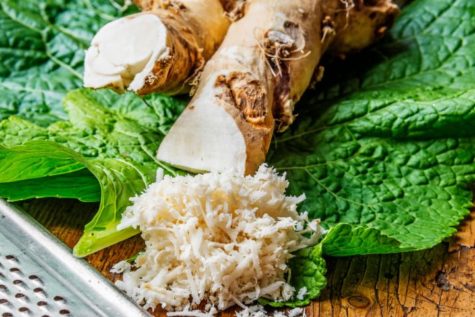
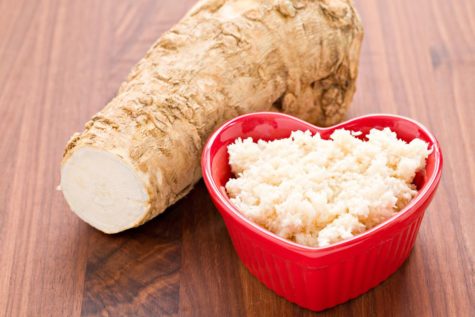
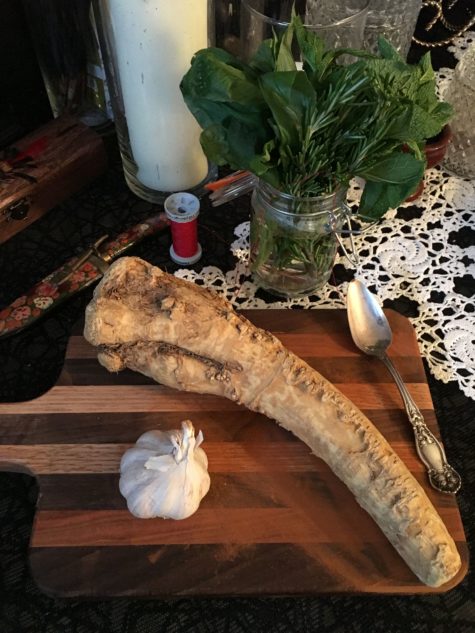
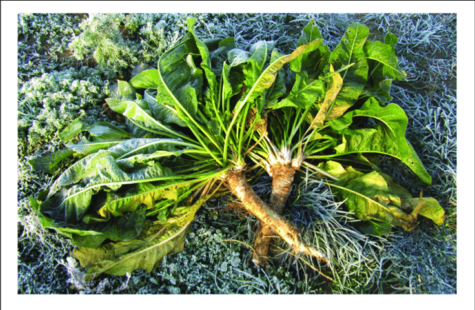
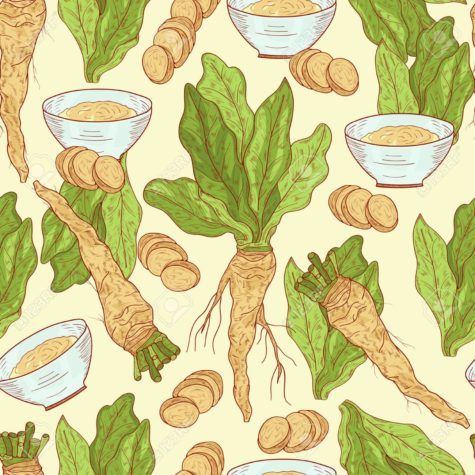
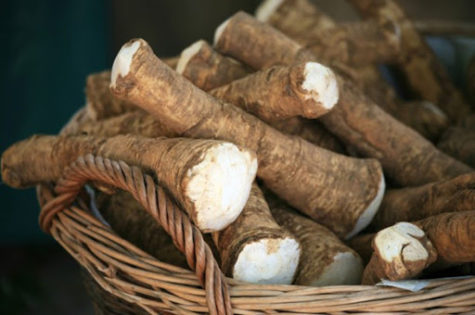


Leave a Reply